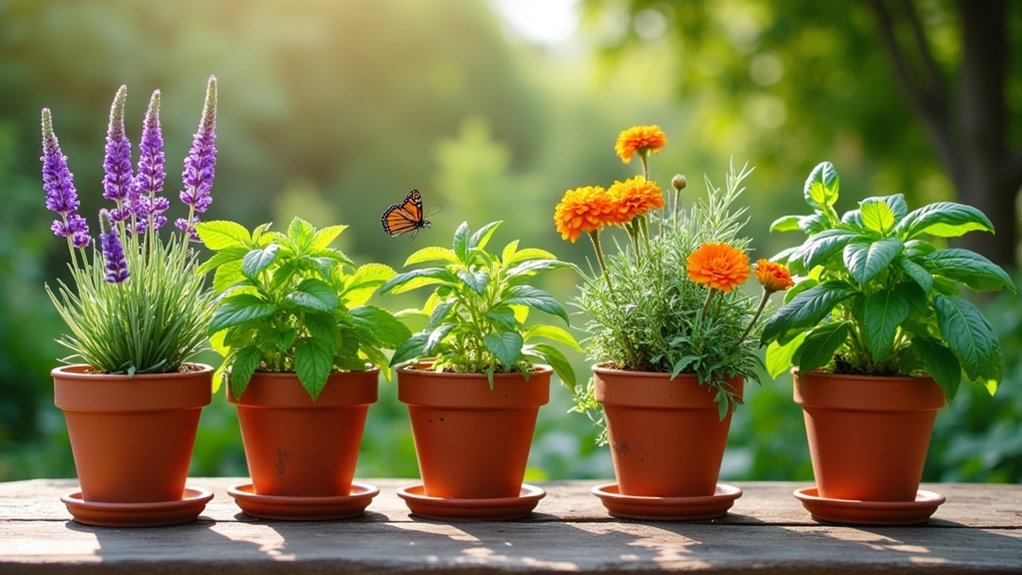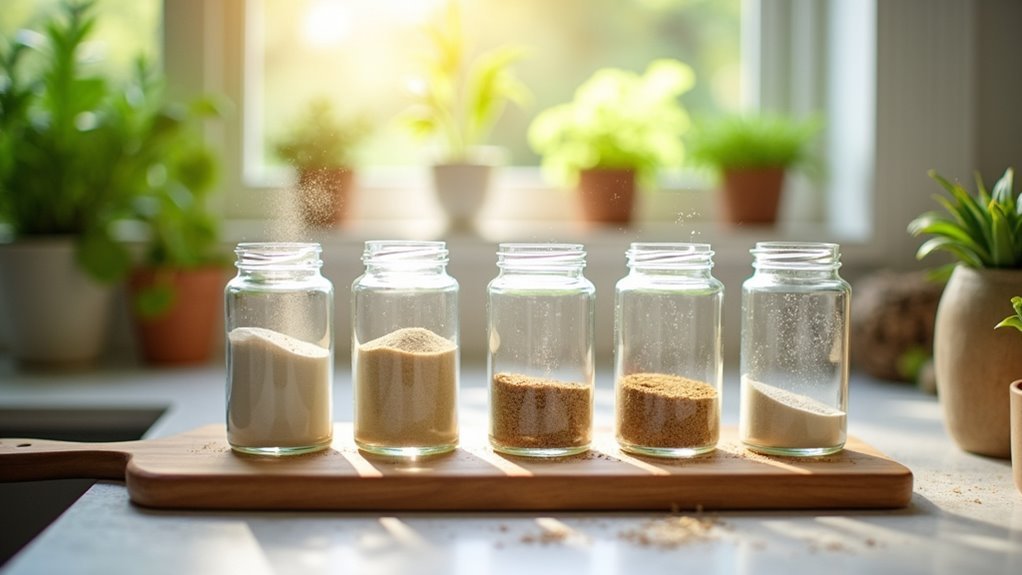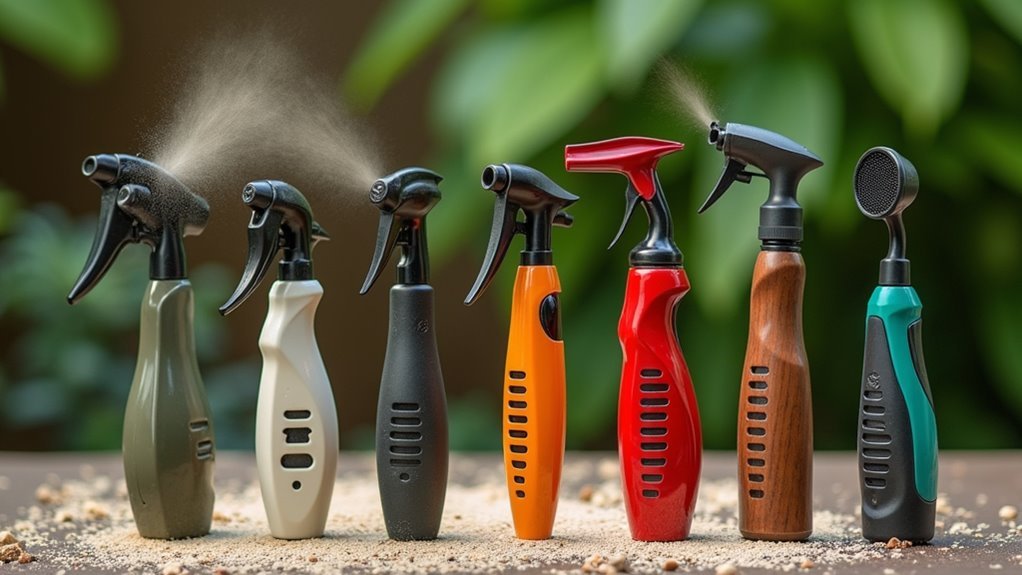Are you tired of battling garden pests but hesitant to use harsh chemicals? You’re not alone. Many gardeners struggle to find natural solutions that actually deliver results. Garden experts have identified five powerful plants that can transform your pest control strategy while enhancing your garden’s beauty. These aromatic defenders work by naturally repelling common garden invaders through their scents and compounds—no synthetic pesticides required. Let’s explore these botanical allies that seasoned gardeners swear by.
Costa Farms Live Indoor Houseplants (3 Pack)
If you’re battling both indoor air quality issues and want decorative elements for your home, Costa Farms’ trio of houseplants delivers double benefits. These air-purifying plants filter toxins while adding natural humidity to improve breathing conditions.
You’ll appreciate their versatility—perfect for home offices, living rooms, or windowsills. Studies show these plants can boost your mood, enhance creativity, and reduce stress levels.
Care is straightforward: place in bright areas and water weekly, adjusting as needed. Standing 8-10 inches tall in modern 4-inch pots, they’re ideal gifts for any occasion. Each plant arrives farm-fresh with detailed care instructions to guarantee they thrive in your space.
Best For: Plant enthusiasts seeking to improve indoor air quality while adding decorative greenery to their homes, offices, or as thoughtful gifts for special occasions.
Pros:
- Natural air purifiers that filter toxins while adding humidity to improve breathing conditions
- Versatile decor pieces that enhance mood, creativity, and reduce stress levels according to studies
- Arrives well-packaged with care instructions, making maintenance straightforward even for beginners
Cons:
- Requires weekly watering and bright placement, which may be challenging in low-light environments
- Limited information about specific plant varieties included in the pack
- At 8-10 inches tall, may be smaller than some customers expect for immediate visual impact
STEM Insect Spray for Indoor and Outdoor Plants (12 oz)
Plant enthusiasts seeking a family-friendly pest control solution will appreciate STEM Insect Spray’s botanical formula. This water-based insecticide effectively targets common garden pests like aphids and spider mites while remaining safe for households with children and pets.
Derived from cedarwood extract, STEM avoids harsh chemicals and added dyes. While many users report successful pest elimination and improved plant health, experiences do vary. Some customers note issues including strong odors, potential leaf damage on sensitive plants, and occasional bottle leakage.
For best results, apply directly to leaves and soil when pests are most active, but guarantee proper ventilation in smaller spaces due to the potent scent.
Best For: Plant owners looking for a botanical pest control solution that is safe to use around children and pets while effectively targeting common garden pests like aphids and spider mites.
Pros:
- Formulated with natural cedarwood extract without harsh chemicals, dyes, or strong chemical odors
- Safe for use around family members and pets when used as directed
- Entomologist-tested for effectiveness against common plant pests like aphids, spider mites, and thrips
Cons:
- Some users report strong odor requiring ventilation, especially in smaller spaces
- May cause leaf damage or scorch on certain sensitive plants
- Inconsistent effectiveness with mixed customer reviews and reports of bottle leakage issues
Kates Garden Plant Spray for Indoor Plants (16oz, Pet Safe)
Pet owners struggling with persistent indoor plant pests finally have a safe solution. This non-toxic spray harnesses natural ingredients like peppermint and rosemary oil to eliminate fungus gnats, spider mites, and fruit flies without endangering your furry friends.
To use effectively, shake well and test on a leaf or two first. Apply directly to soil to target pests and their eggs. The 16oz bottle provides up to 1,500 applications, making it economical for long-term use.
While many users report complete elimination of gnats after several applications, be mindful of the strong peppermint scent and use in well-ventilated areas.
Best For: Plant enthusiasts who need a natural, pet-safe solution to eliminate common indoor plant pests like fungus gnats and spider mites.
Pros:
- Made with natural ingredients like peppermint and rosemary oil, making it safe for use around pets and children
- Economical with up to 1,500 applications per 16oz bottle, providing long-term pest control value
- Effective against multiple pests including fungus gnats, spider mites, and fruit flies when used consistently
Cons:
- Strong peppermint scent may be overwhelming and linger longer than expected
- Some users report poor air quality and high VOC levels after application, requiring good ventilation
- May require multiple applications over several weeks to fully eliminate severe pest infestations
Kates Home & Garden Plant Spray for Insects & Gnats with Sticky Traps
For gardeners seeking an extensive pest management solution, Kates Home & Garden Plant Spray offers a powerful two-pronged approach to insect control. This 16oz bottle combines natural peppermint and rosemary oils to target fungus gnats, spider mites, and fruit flies, while the included 12 sticky traps capture persistent pests.
You’ll appreciate the non-toxic formula that’s safe around children and pets when used as directed. Simply shake, test on a couple leaves, then spray thoroughly, avoiding new growth. For thorough protection, apply directly to soil to eliminate eggs and larvae. With weekly applications and up to 1,500 sprays per bottle, you’ll maintain a pest-free environment both indoors and out.
Best For: Indoor plant enthusiasts and gardeners looking for a natural, comprehensive solution to eliminate and prevent insect infestations, particularly fungus gnats, spider mites, and fruit flies.
Pros:
- Dual-action approach with plant spray and sticky traps provides complete pest management
- Natural formula with peppermint and rosemary oils offers a non-toxic alternative to chemical pesticides
- Versatile application for both indoor houseplants and outdoor gardens with long-lasting effectiveness (up to 1,500 sprays)
Cons:
- Requires consistent weekly application for optimal results
- Need to test on leaves first and avoid spraying new growth, adding extra steps to the process
- Some pests may develop resistance to natural oils over time, potentially requiring rotation with other products
Bonide Captain Jacks Insecticidal Super Soap for Organic Gardening (32 oz Spray)
Organic gardeners searching for a powerful yet eco-friendly solution to combat pesky invaders will appreciate Bonide Captain Jack’s Insecticidal Super Soap. This ready-to-use spray tackles everything from aphids and ants to caterpillars and mites through both contact and ingestion.
You’ll find it works impressively on a wide variety of plants including herbs, vegetables, fruit trees, and ornamentals. The dual-action formula also fights powdery mildew, making it versatile for your garden’s needs. While some persistent infestations may require multiple applications, most users report dramatic improvements after just a few treatments. At 4.5 stars from over 1,500 reviewers, it’s proven effective for organic gardening challenges.
Best For: Organic gardeners wanting an effective, environmentally-friendly solution to combat a wide range of garden pests while being safe to use on various plants from herbs and vegetables to fruit trees.
Pros:
- Dual-action formula kills pests both on contact and through ingestion, while also fighting powdery mildew
- Ready-to-use spray with convenient nozzle requires no mixing or additional equipment
- Approved for organic gardening with impressive 4.5-star rating from over 1,500 users
Cons:
- May require multiple applications for persistent or severe infestations
- At 32 oz, might need frequent repurchasing for larger gardens or ongoing pest problems
- Some users might find the 2.09 lb weight slightly cumbersome for extended spraying sessions
Factors to Consider When Choosing Pest-Repelling Plants That Actually Make a Difference
When choosing pest-repelling plants that truly work, you’ll need to match specific plants to your target pests while ensuring they’re compatible with your local climate and growing conditions. The most effective options typically feature strong aromatic properties that naturally deter insects and other unwanted visitors. Strategic placement of these plants throughout your garden, patio, or indoor spaces maximizes their protective benefits and creates a thorough defense system.
Pest Target Specificity
While many gardeners enthusiastically add pest-repelling plants to their gardens, understanding pest target specificity remains essential for effective natural pest management. Different plants target distinct pests—marigolds repel nematodes and aphids, while basil deters flies and mosquitoes.
You’ll need to identify your specific pest problems before selecting plants. A single variety won’t address all issues, as effectiveness varies by insect species. Consider creating a diverse plant selection that addresses multiple pest concerns simultaneously.
Strategic placement matters considerably. Position your pest-repelling plants directly alongside vulnerable crops to create protective barriers. Aromatic options like lavender and rosemary are particularly effective, releasing compounds that confuse pests and reduce infestation rates.
For maximum effectiveness, implement companion planting techniques, surrounding susceptible plants with pest-specific repellents that target your garden’s most problematic insects.
Climate Compatibility
Beyond identifying specific pest targets, your success with natural repellent plants hinges considerably on climate compatibility. Plants that thrive in their preferred environment will offer stronger pest-repelling properties than those struggling in unsuitable conditions.
Before purchasing, research each plant’s native climate zone. Warm-climate species like citronella may falter in cooler regions, while humidity-loving plants won’t survive in arid landscapes. Consider your local seasonal patterns and rainfall averages when making selections.
Climate-adapted plants develop greater resilience against environmental stressors, enhancing their natural ability to ward off unwanted insects. They’ll require less maintenance and provide more consistent protection throughout growing seasons.
Match your pest-repelling garden to your specific regional conditions—it’s the difference between a thriving defensive barrier and a collection of stressed, ineffective plants.
Growth Requirements
Successful pest-repelling plants don’t just need the right climate—they demand specific growth conditions to maximize their protective properties. Most thrive in bright, indirect sunlight while requiring consistent watering schedules to prevent stress that could diminish their effectiveness.
Pay close attention to soil quality—well-draining mixtures prevent root rot while supporting robust growth. You’ll find many pest-deterrent varieties flourish in warm, humid environments that mirror their native habitats, so monitor both temperature and humidity levels in your growing space.
Fertilization needs vary greatly; some plants require regular feeding during growth periods to enhance their natural pest-resistant compounds. Don’t overlook repotting—plan to refresh soil and provide additional space every 1-2 years. This prevents roots from becoming bound and guarantees continuous access to nutrients that power their pest-repelling abilities.
Strong Aromatic Properties
The most effective pest-repelling plants share one standout characteristic—their powerful aromatic properties. These plants, like peppermint and rosemary, release essential oils that naturally deter mosquitoes, flies, and aphids by disrupting their sensory receptors, making it difficult for them to find food.
You’ll see impressive results with aromatic plants in your garden, as studies show they can reduce pest populations by up to 50% without chemical interventions. When you integrate these fragrant varieties into your landscape, you’re not just controlling pests—you’re creating a balanced ecosystem.
The oils released don’t just repel unwanted visitors; they actually attract beneficial insects like ladybugs and lacewings that prey on harmful pests. As a bonus, you’ll enjoy improved air quality and enhanced beauty in your outdoor spaces.
Placement Within Spaces
Strategic placement of pest-repelling plants determines their effectiveness in your garden and home. Position these natural deterrents where pests commonly enter—near windows, doors, and other entry points—to create a protective barrier against unwanted insects.
For maximum impact, group compatible repellent plants together to create synergistic zones that ward off a wider variety of pests. You’ll want to evaluate each plant’s sunlight and humidity requirements, ensuring they’re placed in conditions that mirror their natural habitats.
Don’t forget to vary the heights and spacing of your pest-repelling plants to improve air circulation and prevent overcrowding, which can actually attract pests. Finally, try rotating your plants periodically to disrupt established pest patterns and prevent infestations from becoming entrenched in specific areas of your garden.
Required Maintenance Level
While plant placement creates your first line of defense, understanding maintenance requirements guarantees your pest-repelling strategy remains effective long-term. Select plants that align with your lifestyle and available time commitment.
Many pest-repelling herbs thrive with minimal care, requiring only occasional watering and pruning—perfect for busy gardeners. Before choosing plants, assess their growth habits, as some varieties need more space and attention than others.
Remember that indoor and outdoor plants have different needs. Indoor varieties often require specific humidity levels and light exposure, while outdoor plants may need seasonal adjustments. Consider soil requirements too—some plants need well-draining soil while others prefer moisture retention.
Match plants to your environment and schedule for maximum pest-repelling effectiveness without creating an overwhelming maintenance burden.
Companion Planting Benefits
Maximizing the power of pest-repelling plants requires thoughtful companion planting, where strategic combinations create a more effective defense system than individual plants alone. Research shows these partnerships can reduce pest populations by up to 50% while simultaneously improving your garden’s overall health.
Aromatic herbs like basil and mint pull double duty—repelling harmful insects while attracting beneficial pollinators that enhance plant productivity. Meanwhile, flowers such as marigolds release natural compounds that specifically target nematodes and aphids, protecting nearby vegetable crops from damage.
Beyond pest management, companion planting improves soil quality and nutrient availability, leading to stronger plants and potentially higher yields. You’ll also reduce your need for chemical pesticides, creating a more sustainable garden ecosystem that benefits both your plants and the environment.
Indoor Vs Outdoor Effectiveness
The effectiveness of pest-repelling plants differs markedly between indoor and outdoor environments, requiring gardeners to make informed choices based on specific conditions.
When you’re selecting indoor plants, consider options like spider plants and peace lilies that pull double duty—purifying your air while deterring common household pests. However, remember that enclosed spaces can sometimes intensify pest problems, so you’ll likely need supplementary management strategies.
Outdoor pest-repellers like marigolds and citronella typically perform better against insects such as mosquitoes and aphids, thanks to their natural compounds and stronger scents being freely dispersed in open air.
For maximum effectiveness in either setting, try creating diverse plant combinations. Research shows that thoughtful groupings enhance pest-repelling capabilities by establishing more balanced ecosystems, giving you better results than single-plant solutions.
Frequently Asked Questions
How Long Do Pest-Repelling Plants Remain Effective?
You’ll find that most pest-repelling plants stay effective throughout their growing season. Some perennials will work for years if maintained properly, while annuals need yearly replanting. Regular pruning enhances their repelling capabilities.
Can Pest-Repelling Plants Harm Beneficial Insects Like Bees?
Most pest-repelling plants won’t harm bees. You’ll find that species like lavender, mint, and marigolds actually attract beneficial pollinators while deterring pests. Choose your plants wisely for a balanced garden ecosystem.
Which Pests Are Most Resistant to Plant-Based Repellents?
Mosquitoes, Japanese beetles, spider mites, and certain aphid species are most resistant to plant-based repellents. You’ll find they often adapt quickly, so you’ll need stronger methods or combination approaches for effective control.
Do Pest-Repelling Plants Work in All Climate Zones?
No, pest-repelling plants don’t work equally in all climate zones. You’ll find their effectiveness varies by region, as some plants won’t thrive in certain temperatures or moisture levels, reducing their repellent properties.
How Close Should Pest-Repelling Plants Be to Vegetables for Protection?
Plant your pest-repelling companions within 1-3 feet of vegetables for effective protection. You’ll get best results when they’re interplanted directly among your crops rather than isolated at the garden’s edge.





Leave a Reply